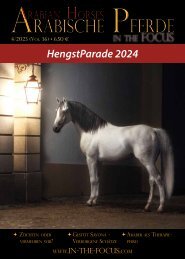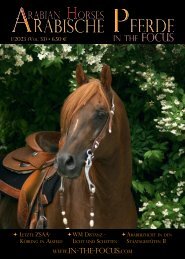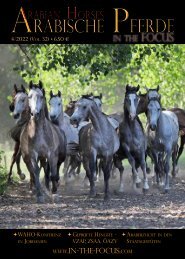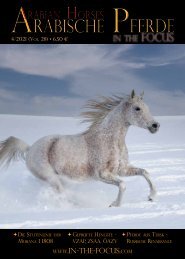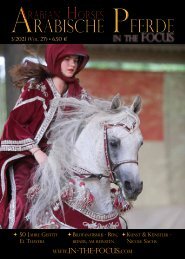Arabische Pferde IN THE FOCUS Nr. 3-2020 (Vol. 23) - public
Zeitschrift für Liebhaber und Züchter arabischer Pferde
Zeitschrift für Liebhaber und Züchter arabischer Pferde
Erfolgreiche ePaper selbst erstellen
Machen Sie aus Ihren PDF Publikationen ein blätterbares Flipbook mit unserer einzigartigen Google optimierten e-Paper Software.
Zucht<br />
Szymon Mohort (a fictional character from the verse epic by Wincenty Pol), presents his stud to Prince Józef Poniatowski. - Szymon Mohort (eine<br />
fiktionale Figur im Versepos von Wincenty Pol), präsentiert sein Gestüt dem Prinzen Jozef Poniatowski.<br />
Gemälde / painting by: Juliusz Kossak<br />
mounting them on his Arabian horses, and led<br />
them at the Battle of Daszów, on the Polish side.<br />
The battle ended in a rout for the Polish forces,<br />
and Rzewuski was not seen again, though his<br />
stallion returned tackless and bloodstained to<br />
his stables. As Rzewuski had fought for Poland,<br />
the victorious Russians confiscated his estates<br />
and dispersed the herd, destroying a decade of<br />
asil Arabian breeding in one fell swoop.<br />
However, the studs of the Sanguszkos, the Branickis<br />
and the Potockis were preserved, and continued<br />
to breed Arabian horses. In 1843, Count<br />
Juliusz Dzieduszycki joined their ranks, inspired<br />
by the tales of the fabled Emir Rzewuski. His<br />
father Kajetan had purchased horses from the<br />
Sanguszkos and Rzewuski, as well as the imported<br />
desertbred stallion Bagdad, whom he had<br />
acquired from the Greek dealer Nicolás Gliocho.<br />
The story goes that Kajetan sent his son Juliusz<br />
to negotiate with Gliocho, after refusing to pay<br />
the exorbitant price the dealer had asked; unfortunately<br />
for Kajetan, Juliusz took one look at<br />
the horse and handed over all the money he had<br />
brought, sold the carriage and the horses he had<br />
driven down to Lvov, and rode Bagdad back to<br />
the Dzieduszycki stud at Jarczowce - while the<br />
poor coachman had to walk back.<br />
Gazella, Mlecha, Sahara<br />
Four years after the purchase of Bagdad, Juliusz<br />
Dzieduszycki made his way to the deserts of Arabia<br />
himself, to find more horses of a similar quality<br />
to Bagdad. Amongst the horses he brought<br />
back were the mares Gazella, Mlecha and Sahara,<br />
the founders of Polish female families I-III, as<br />
well as the stallions Koheilan, Abiad and Abu<br />
Cheil, the last of which was acquired not-so-honestly,<br />
as the Bedouin sold him to Dzieduszycki<br />
on the strength of their relationship with Rzewuski,<br />
expecting to be allowed to use the stallion<br />
to cover their mares before Dzieduszycki took<br />
him from the desert. Dzieduszycki, however, reneged<br />
on his side of the agreement, and made<br />
off with Abu Cheil as soon as possible. This may<br />
have been because he did not want to sit in the<br />
desert for a year or so, letting the Bedouin breed<br />
their mares to his stallion; it may also have been<br />
because he doubted whether he would be allowed<br />
to actually take the stallion from the desert,<br />
as sometimes particularly prized horses would<br />
be recaptured via raiding, or killed to keep them<br />
from falling into the hands of outsiders.<br />
By the mid-nineteenth century, the great private<br />
studs of Poland were flourishing. They were no<br />
longer simply breeding Arabian horses, but had<br />
also begun to race them, first at the stud farms,<br />
but then at racecourses in major cities, such as<br />
Warsaw and Moscow. The Polish Arabian is not<br />
just the oldest purebred Arabian in Europe, but<br />
also the first to be performance-tested, a tradition<br />
maintained to this day. With racing on the rise<br />
in India as well under the British Raj, some of the<br />
stars of the Indian track found their way to Poland,<br />
amongst them the two Indjanins (the first<br />
imported in 1859 by the Sanguszkos, later renamed<br />
Nizam when acquired by the Branickis for<br />
Biała Cerkiew; and the second imported in 1863<br />
by the Branickis), Hussar (for Białocerkiew), Faraon<br />
(for Sławuta), and Hermit (imported in 1910<br />
by Władysław Dzieduszycki).<br />
Throughout the nineteenth century, the aristocratic<br />
families continued to import horses<br />
from the desert, to keep refreshing and concentrating<br />
the qualities of the desertbred horse.<br />
They were particularly fond of the Saqlawi<br />
strain - a significant number of the horses<br />
exported from the desert by Europeans from<br />
the mid nineteenth to early twentieth century<br />
are Saqlawi Jadran - but it was by no means<br />
the only strain they selected. The mare Elsissa,<br />
founder of female family IV, is a Hadbat Enzahiyah,<br />
while Dzieduszycki’s mares Gazella,<br />
Mlecha and Sahara are Kuhaylat al-’Ajuz, Kuhaylah<br />
Da’janiyah, and Kuhaylah Moradiyah<br />
respectively. Nonetheless, the esteem in which<br />
the Saqlawi was held by the Poles can still be<br />
seen in Edward Skorkowski’s Arab Breeding of<br />
Poland, where he claims that the Sławuta mares<br />
Milordka and Woloszka show features of the<br />
strain, based on skull measurements.<br />
English Connections<br />
The Sanguszko stud of Antoniny passed to the<br />
Potocki family when Prince Roman Stanisław<br />
Sanguszko’s daughter Maria married Count<br />
Alfred Józef Potocki in 1851. Maria and Alfred’s<br />
son, Józef Potocki, was on friendly terms with the<br />
Blunts, having purchased their desertbred stallion<br />
Pharaoh at the first Crabbet auction in July<br />
1882, and in 1884 Lady Anne and Wilfrid visited<br />
the Potocki family in Russia (Poland did not currently<br />
exist as an independent state), receiving a<br />
guided tour of Antoniny as well as Biała Cerkiew,<br />
since Józef’s brother Roman was the father-inlaw<br />
of the current Count Branicki. Antoniny had<br />
22<br />
© ARABISCHE PFERDE - <strong>IN</strong> <strong>THE</strong> <strong>FOCUS</strong> 3/<strong>2020</strong>




